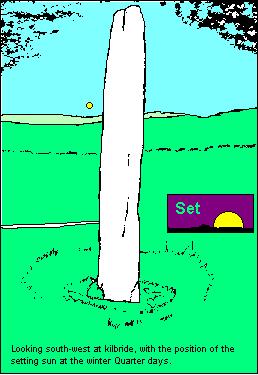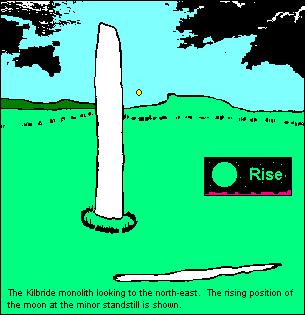
Kilbride standing stone, Islay
Stones
of Wonder
QUICK LINKS ...
HOME PAGE
INTRODUCTION
WATCHING
THE SUN, MOON AND STARS
THE
MONUMENTS
THE
PEOPLE AND THE SKY
BACKGROUND
ARCHAEOASTRONOMY
USING
THE SITE DESCRIPTION PAGES
VISITING
THE SITES
THE
LEY LINE MYSTERY
THE
SITES
ARGYLL
AND ARRAN
MID
AND SOUTH SCOTLAND
NORTH
AND NORTH-EAST SCOTLAND
WESTERN
ISLES AND MULL
Data
DATES
OF EQUINOXES AND SOLSTICES, 1997 to 2030 AD
DATES
OF MIDSUMMER AND MIDWINTER FULL MOONS, 1997 to 2030 AD
POSTSCRIPT
Individual
Site References
Bibliography
Links
to other relevant pages
Contact
me at : rpollock456@gmail.com
Standing Stone NR384466*
How to find: Go east from Port Ellen and only 200m out of the town turn left into a minor road. Follow this road to the end, a distance of 2km. The standing stone is visible in the pasture field to the right.
Best time of year to visit: Sunset at winter Quarter days. Lunar minor standstill.


This fine slab is 2.5 metres tall and about one metre wide by 40cm. The slab formerly had a partner, for lying in the turf about three metres to the south-west is another stone which seems to be about three metres long ; when standing, it would have been in line with the surviving stone. So this was clearly a site of some significance to the builders.
At this site we have a choice about the intended celestial event the stones are intended to mark.
To the south-west, the azimuth range covered by the stone to an observer a short distance away is 234.9° to 239.6°, which with a horizon height of 0.7° give declinations in the range -18.7° to -16.1°. This covers the position of the setting sun at the winter Quarter Days about November 7th -16th and January 27th - February 4th. This suggested indication may be acceptable if you believe in a Neolithic or Bronze age calendar system which involved the counting of the days of the year.
To the north-east, the opposite azimuth band with a horizon height of 1° produces declinations in the range +19.5° to +17.2°, which covers the rising position of the midwinter moon at the minor standstill.